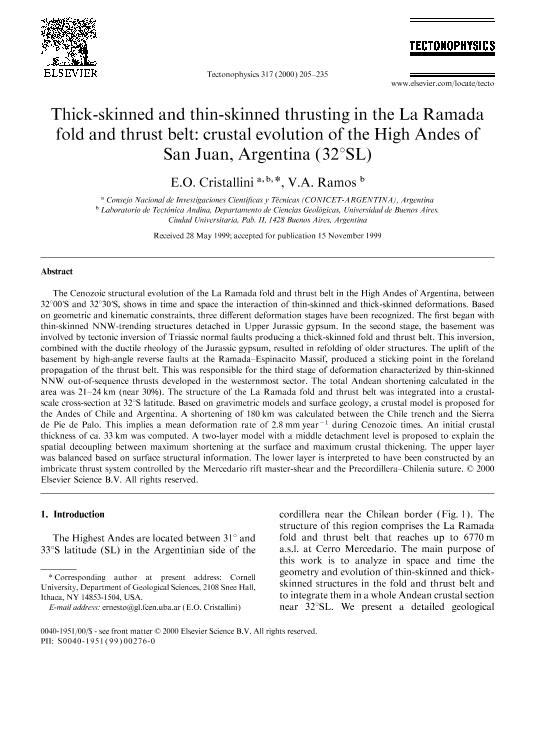Artículo
Thick-skinned and thin-skinned thrusting in La Ramada fold and thrust belt : Crustal evolution of the High Andes of San Juan, Argentina (32° SL)
Fecha de publicación:
12/2000
Editorial:
Elsevier Science
Revista:
Tectonophysics
ISSN:
0040-1951
Idioma:
Inglés
Tipo de recurso:
Artículo publicado
Clasificación temática:
Resumen
The Cenozoic structural evolution of the La Ramada fold and thrust belt in the High Andes of Argentina, between 32°00'S and 32°30'S, shows in time and space the interaction of thin-skinned and thick-skinned deformations. Based on geometric and kinematic constraints, three different deformation stages have been recognized. The first began with thin-skinned NNW-trending structures detached in Upper Jurassic gypsum. In the second stage, the basement was involved by tectonic inversion of Triassic normal faults producing a thick-skinned fold and thrust belt. This inversion, combined with the ductile rheology of the Jurassic gypsum, resulted in refolding of older structures. The uplift of the basement by high-angle reverse faults at the Ramada-Espinacito Massif, produced a sticking point in the foreland propagation of the thrust belt. This was responsible for the third stage of deformation characterized by thin-skinned NNW out-of-sequence thrusts developed in the westernmost sector. The total Andean shortening calculated in the area was 21-24 km (near 30%). The structure of the La Ramada fold and thrust belt was integrated into a crustal-scale cross-section at 32°S latitude. Based on gravimetric models and surface geology, a crustal model is proposed for the Andes of Chile and Argentina. A shortening of 180 km was calculated between the Chile trench and the Sierra de Pie de Palo. This implies a mean deformation rate of 2.8 mm year-1 during Cenozoic times. An initial crustal thickness of ca. 33 km was computed. A two-layer model with a middle detachment level is proposed to explain the spatial decoupling between maximum shortening at the surface and maximum crustal thickening. The upper layer was balanced based on surface structural information. The lower layer is interpreted to have been constructed by an imbricate thrust system controlled by the Mercedario rift master-shear and the Precordillera-Chilenia suture.
Archivos asociados
Licencia
Identificadores
Colecciones
Articulos(IDEAN)
Articulos de INSTITUTO DE ESTUDIOS ANDINOS "DON PABLO GROEBER"
Articulos de INSTITUTO DE ESTUDIOS ANDINOS "DON PABLO GROEBER"
Citación
Cristallini, Ernesto Osvaldo; Ramos, Victor Alberto; Thick-skinned and thin-skinned thrusting in La Ramada fold and thrust belt : Crustal evolution of the High Andes of San Juan, Argentina (32° SL); Elsevier Science; Tectonophysics; 317; 3-4; 12-2000; 205-235
Compartir
Altmétricas




